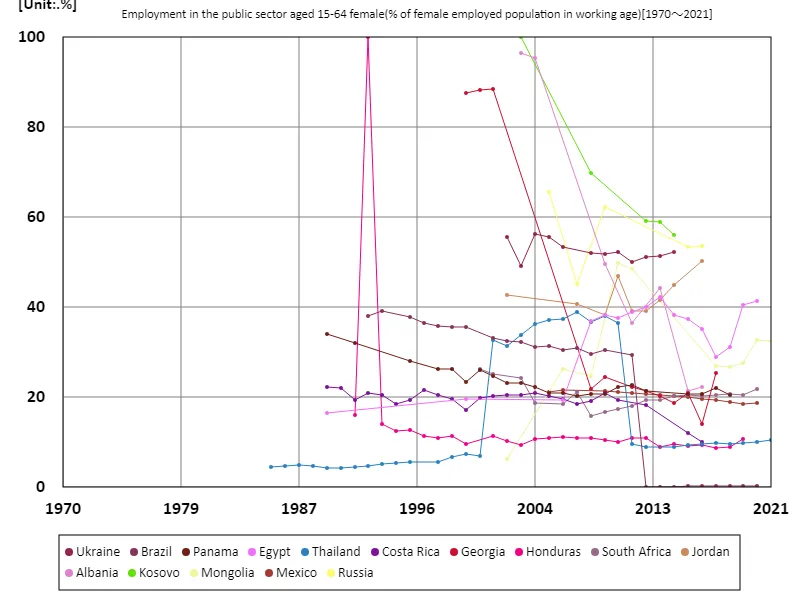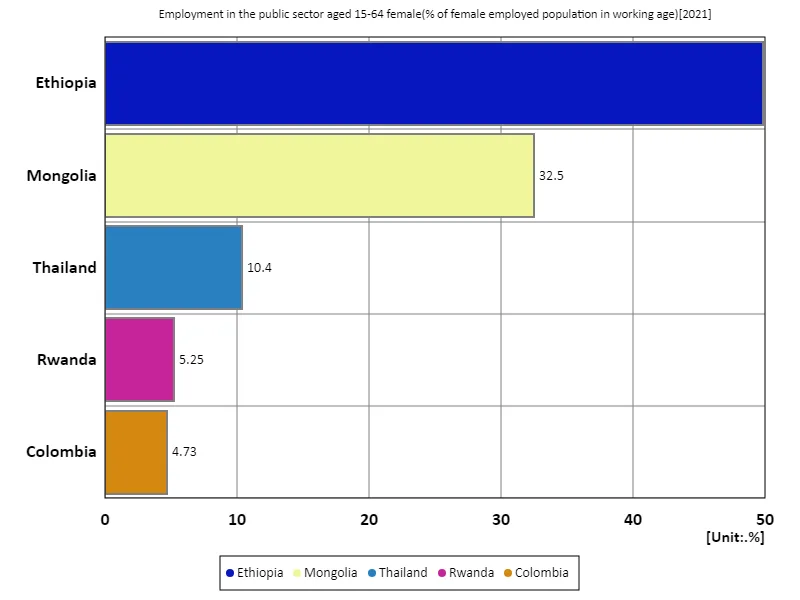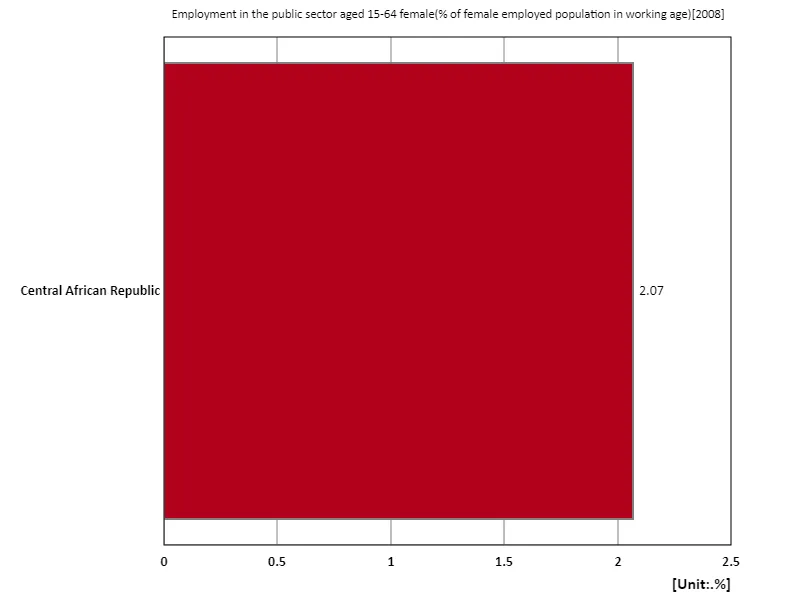- Abstract
- Employment rate in the public sector for women aged 15-64 (percentage of working-age women in the labour force)
- Public sector employment rate for women aged 15-64 (percentage of working-age female employed population) (Worldwide)
- Women aged 15-64, public sector employment rate (percentage of working-age female employment population) (World, latest year)
- Employment rate in the public sector for women aged 15-64 (percentage of working-age women in the labour force) (region, latest year)
- Reference
Abstract
Employment rates for women aged 15-64 in the public sector reflect differences in labour markets and social policies across countries. According to 2021 data, Thailand has the highest employment rate at 10.4%. This high percentage is likely due to Thailand’s expansion of the public sector and policies to promote female labor participation. Thailand is increasing employment opportunities for women and promoting social stability through public sector employment. On the other hand, in many countries public sector employment is relatively low, with private sector employment dominating. This is due to constraints on the size and budget of the public sector, or the expansion of the market economy and the resulting surge in the private sector. For example, while public sector employment rates have remained relatively stable in developed countries, the overall employment structure is changing due to the digitalization and increasing privatization of the economy. Overall, while public sector employment offers a stable working environment, it is strongly influenced by economic trends and policies, and therefore fluctuates depending on the economic situation and policies of each country. The example of Thailand illustrates the impact that an active public sector role can have on female employment and has policy implications for other countries.
Employment rate in the public sector for women aged 15-64 (percentage of working-age women in the labour force)
Looking back at data from 1985 to 2021, we see a notable change in employment rates for women aged 15-64 in the public sector. Honduras’ astounding figure of 100% in 1992 indicates that the public sector was the primary source of female employment. However, subsequent data shows that Honduras’ employment rate has fallen significantly, to 10.7% in 2021. This is thought to be due to the shrinking of the public sector, the expansion of the private sector, and economic reforms. This trend is common in other countries as well. In many countries, public sector employment is declining and the private sector is increasing as economies become more globalized and privatized. In particular, in developing countries, there is a strong tendency for governments to downsize their public sectors due to budget constraints and efficiency measures, which is also affecting employment opportunities for women. Moreover, as economies mature, public sector employment rates in developed countries have remained stable while women’s employment in the private sector has increased. This change suggests that while expanding women’s participation in the labor market, policies will need to be adjusted to accommodate changes in the economic environment. The example of Honduras illustrates how economic trends and policies affect women’s employment.


The maximum is 100%[1992] of Honduras, and the current value is about 10.7%
Public sector employment rate for women aged 15-64 (percentage of working-age female employed population) (Worldwide)
Data from 1985 to 2021 show clear changes in public sector employment rates for women aged 15-64. Honduras recorded a particularly extreme figure of 100 percent in 1992, reflecting a time when the public sector was the primary source of female employment. However, in 2021, Honduras’ employment rate has fallen to 10.7%, a drop that is due to a number of factors. Honduras’s rapid transformation can be seen as a result of economic reforms, public sector retrenchment, and budgetary constraints. Since the 1990s, economic globalization and privatization have progressed in many countries, resulting in a reduction in the size of the public sector. This has led to a decline in public sector employment opportunities for women and an increase in private sector employment. On the other hand, in developed countries, public sector employment rates are often relatively stable, with a certain amount of employment maintained as part of social security and public services. However, the overall trend is that as economies mature and become more efficient, public sector employment is declining and private sector employment is increasing. This variation reflects different policies and economic conditions across countries and indicates their impact on women’s labour markets.


The maximum is 100%[1992] of Honduras, and the current value is about 10.7%
Women aged 15-64, public sector employment rate (percentage of working-age female employment population) (World, latest year)
Based on 2021 data, there is wide variation across countries in public sector employment rates for women aged 15-64. Ethiopia’s figure of 49.9% is particularly high, indicating that the public sector plays an important role in women’s employment. This high rate is due to Ethiopia’s efforts to encourage women to enter the labor market through the public sector. However, the average employment rate is 20.5%, indicating that public sector employment is limited in many countries. In countries with low public sector employment rates, the privatization of the economy and the downsizing of the public sector have led to a shift in employment opportunities for women primarily to the private sector. The ”sum of 103%” figure may suggest different data sources or methodologies, and it is possible that some women are actually employed in more than one public sector position. Overall, public sector employment rates vary widely depending on a country’s economic situation and policies. Countries with high public sector employment provide stable work opportunities for women and contribute to social stability. On the other hand, countries with low public sector employment have more job opportunities in the private sector, reflecting economic dynamism.


The maximum is 49.9% of Ethiopia, the average is 20.5%, and the total is 103%
Employment rate in the public sector for women aged 15-64 (percentage of working-age women in the labour force) (region, latest year)
According to 2008 data, the overall public sector employment rate for women aged 15-64 was 2.07%, with the Central African Republic recording the highest figure. The figures indicate that female employment in the public sector is relatively low globally. In particular, the Central African Republic’s figure of 2.07% may suggest a small public sector or limited representation of women in the public sector. This low employment rate is common in many developing countries and is a result of resource and budget constraints in the public sector or the dominance of the private sector. In developing countries, public sector employment is limited, so women’s primary labour market option is often the private sector. Economic constraints and policy differences also play a role. Compared to developed countries, developing countries tend to have relatively fewer public sector jobs and more employment opportunities for women in the private sector. Low public sector employment rates are due to sluggish economic growth and a shortage of public services, which affect women’s labour market options. Overall, the 2008 data reflects low female employment in the public sector and the economic and policy contexts of the countries.


The maximum is 2.07% of Central African Republic, the average is 2.07%, and the total is 2.07%



Comments